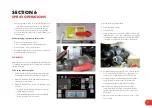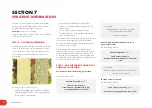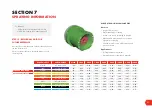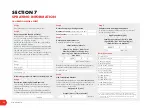
HT-OMSMART-A
58
STEP 2 - DETERMINING THE ACTUAL
SPEED OF TRAVEL
Your sprayer has been factory set with a calibration
number. This should be fine tuned prior to commencement
of spraying and checked by your dealer. This is done
by traveling a known distance (usually 100 metres) and
comparing the distance measured by the Spray Controller
to the known distance. If there is a discrepancy, the Spray
Controller Manual explains how to easily adjust the
calibration number automatically.
To manual check the speed…
a) Half fill the sprayer tank with water and mark out a test
strip of 100 metres (simulating spraying conditions).
b) Set the sprayer operating and record the time taken to
travel 100 metres at your required spraying speed.
c) Calculate the actual speed of travel using the formula:
For SPEED, km/hr =
using the following formula:
Distance (m) x 3.6
Time (sec)
eg. 100(m) x 3.6 ÷ 48(seconds)
= 7.5km/hr travel speed
An alternative formula is:
km/hr = Metres travelled in 1 minute
STEP 3 - DETERMINE SPRAYING
VOLUME REQUIRED
It is essential to determine the liquid volume per hectare
required to effectively spray a crop without overspraying
or underspraying.
The spray volume requirement should be determined by
/ in conjunction with an agronomist / spray manager /
someone skilled in the art of spraying.
The term “litres per hectare” must be related to foliage
and not just to land area. The amount of liquid needed to
effectively spray any given crop will vary greatly with:
• The type of crop
• Row spacing
• Width of canopy
• Height of canopy
• Stage of growth
• Density of foliage
• Type of leaf surface
• Type of fruit (single or bunched)
• Type of sprayer used
STEP 4 - DETERMINE SPRAYER
CONFIGURATION
Once the volume of required spray volume per hectare
is established, the next step in setting up the sprayer is to
determine:
• The
number of row(s)
to be sprayed in one pass, and
• The
total number of nozzles
to be used on the
sprayer. Don’t forget Tier 1, Tier 2 and Tier 3 options.
Both these factors can vary with the model of sprayer used
and other factors mentioned under step 3.
Example A
A 2-row Smart Sprayer to spray vines – using 2 spray fan
per Fan Frame, has a total of 8 spray fans.
Each spray fan has 2 spray rings - with 5 nozzles per ring.
Hence a combined total of 40 nozzles per Tier (8 rings x
5 nozzles).
Therefore Tier 1 = 40 x nozzles, Tier 2 = 40 x nozzles &
Tier 3 = 80 x nozzles.
Example B
A 3-row Smart Sprayer to spray vines – using 3 spray fan
per Fan Frame, has a total of 18 spray fans.
Each spray fan has 2 spray rings - with 5 nozzles per ring.
Hence a combined total of 90 nozzles per Tier (18 rings x
5 nozzles).
Therefore Tier 1 = 90 x nozzles, Tier 2 = 90 x nozzles &
Tier 3 = 180 x nozzles.
SECTION 7
SPRAYING INFORMATION






























